|
|
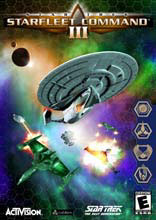
    
by Activision
|
 There are only
so many clever things you can say at the start of a Star Trek review,
and most of those have already been said somewhere in the long history
of Star Trek based game releases. As an aging Treky still coming to
grips with the loss of The Next Generation from our weekly TV line-up (a
wound once again re-opened with the release of Nemesis), it’s always
refreshing for me whenever a game licenses TNG over some of those other
shows (like Voyager…shudder). It’s good to see the Elite Force series,
one of the best Star Trek based game lines on the market, teleporting
across the generation gap to a Starfleet made famous by Jean-Luc Picard.
In the same respect, it’s good to see Starfleet Command III make that
same transition, even going so far as having the captain himself lend
his talents as a voice actor to help narrate the tutorial, and spice up
the storyline. In fact, the combination of voice acting, musical score,
sound effects, and graphic design, make Starfleet Command III the
strongest player on the market when it comes to pure Star Trek TNG
flavor. From the moment the opening cut scene begins to play and Captain
Picard’s voice comes over the speakers, it’s like being teleported back
in time, being reintroduced to an old friend. Starfleet Command III
succeeds in capturing the one thing that every Star Trek game has sought
(and most failed) to offer: a familiar taste of what we lost during that
two-hour finale back in 1994, and have really failed to see anywhere but
the big screen since. There are only
so many clever things you can say at the start of a Star Trek review,
and most of those have already been said somewhere in the long history
of Star Trek based game releases. As an aging Treky still coming to
grips with the loss of The Next Generation from our weekly TV line-up (a
wound once again re-opened with the release of Nemesis), it’s always
refreshing for me whenever a game licenses TNG over some of those other
shows (like Voyager…shudder). It’s good to see the Elite Force series,
one of the best Star Trek based game lines on the market, teleporting
across the generation gap to a Starfleet made famous by Jean-Luc Picard.
In the same respect, it’s good to see Starfleet Command III make that
same transition, even going so far as having the captain himself lend
his talents as a voice actor to help narrate the tutorial, and spice up
the storyline. In fact, the combination of voice acting, musical score,
sound effects, and graphic design, make Starfleet Command III the
strongest player on the market when it comes to pure Star Trek TNG
flavor. From the moment the opening cut scene begins to play and Captain
Picard’s voice comes over the speakers, it’s like being teleported back
in time, being reintroduced to an old friend. Starfleet Command III
succeeds in capturing the one thing that every Star Trek game has sought
(and most failed) to offer: a familiar taste of what we lost during that
two-hour finale back in 1994, and have really failed to see anywhere but
the big screen since.
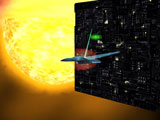 Starfleet
Command III opens in a new era of peace and prosperity between the
Federation and the Klingon Empire, and finds the two constructing an
advanced space station capable of detecting cloaked ships along the edge
of the neutral zone. There are those in the universe, of course, who do
not like this idea much at all, however. Unlike many games that try to
place you in command of well known starships from the series, Starfleet
Command wisely places you in the role of a beginning captain on whatever
side you happen to choose to play (from Federation and Klingon to
Romulan and Borg), letting the significant players appear to progress
the storyline. Starfleet
Command III opens in a new era of peace and prosperity between the
Federation and the Klingon Empire, and finds the two constructing an
advanced space station capable of detecting cloaked ships along the edge
of the neutral zone. There are those in the universe, of course, who do
not like this idea much at all, however. Unlike many games that try to
place you in command of well known starships from the series, Starfleet
Command wisely places you in the role of a beginning captain on whatever
side you happen to choose to play (from Federation and Klingon to
Romulan and Borg), letting the significant players appear to progress
the storyline.
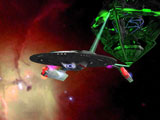 The game
is played from two perspectives; the tactical, hex map of the universe
allows you to direct your ship in and out of friendly and enemy space at
high speeds, jumping from mission to mission. At the same time, the
missions themselves are played from an over-the-shoulder camera angle
that sits behind your ship in classic third person. The two allow for
multiple perspectives of the game, one letting you manage your ship –
replacing crew, armament, and weapons – and view the overall progress of
your alignment, the other letting you blow things up in glorious fashion
with phasers, photon torpedoes, and various other toys. Between the two,
Starfleet Command offers a complex and engaging glimpse into the life of
a Starfleet captain. Broken in half, each element offers a number of
excellent features, and at the same time, a number of items that could
have stood a little more attention during development. The game
is played from two perspectives; the tactical, hex map of the universe
allows you to direct your ship in and out of friendly and enemy space at
high speeds, jumping from mission to mission. At the same time, the
missions themselves are played from an over-the-shoulder camera angle
that sits behind your ship in classic third person. The two allow for
multiple perspectives of the game, one letting you manage your ship –
replacing crew, armament, and weapons – and view the overall progress of
your alignment, the other letting you blow things up in glorious fashion
with phasers, photon torpedoes, and various other toys. Between the two,
Starfleet Command offers a complex and engaging glimpse into the life of
a Starfleet captain. Broken in half, each element offers a number of
excellent features, and at the same time, a number of items that could
have stood a little more attention during development.
 Before you
have a chance to launch into battle, which is really the heart of
Starfleet Command III, you find yourself having to get there. The
topographical hex map shows a great deal of useful information, from
what sort of morale a sector has, to which empire or political
affiliation rules the area. Once you arrive at a specific hex, you can
check your missions log to see if there are any jobs in the area that
need to be done for petty fame points (cash). If there’s a space station
in the area, you can stop off for a drink or two at the local bar, swap
stories with potential crewmen, and pick up new supplies. You can also
look over what new ships and weapons may be available for purchase, and
you’ll quickly find that the pursuit of newer, bigger ships is one of
your favorite pastimes. Every time you earn enough points to pick up a
ship with new gun ports and shield enhancements, you’ll get a thrill
taking it out into the world to kick some alien race’s triangle shaped
bum. Before you
have a chance to launch into battle, which is really the heart of
Starfleet Command III, you find yourself having to get there. The
topographical hex map shows a great deal of useful information, from
what sort of morale a sector has, to which empire or political
affiliation rules the area. Once you arrive at a specific hex, you can
check your missions log to see if there are any jobs in the area that
need to be done for petty fame points (cash). If there’s a space station
in the area, you can stop off for a drink or two at the local bar, swap
stories with potential crewmen, and pick up new supplies. You can also
look over what new ships and weapons may be available for purchase, and
you’ll quickly find that the pursuit of newer, bigger ships is one of
your favorite pastimes. Every time you earn enough points to pick up a
ship with new gun ports and shield enhancements, you’ll get a thrill
taking it out into the world to kick some alien race’s triangle shaped
bum.
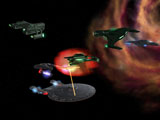 Unfortunately,
there are some glaring omissions in this area of the game that boarder
on frustrating (not quite, but close). For one, and to my major
disappointment, you can’t keep any of the ships that you capture. You
knock down someone’s shields, you beam some soldiers over and take
control of the ship… but for what? Do you get to keep it? Do you get
extra points, or get to sell it for better parts? No. It disappears at
the end of the battle. It drains the fun out of piracy. Unfortunately,
there are some glaring omissions in this area of the game that boarder
on frustrating (not quite, but close). For one, and to my major
disappointment, you can’t keep any of the ships that you capture. You
knock down someone’s shields, you beam some soldiers over and take
control of the ship… but for what? Do you get to keep it? Do you get
extra points, or get to sell it for better parts? No. It disappears at
the end of the battle. It drains the fun out of piracy.
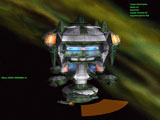 For another,
there isn’t any labeling on the hex map. Often, orders will send you to
a certain hex, like 5, 23, and then expect you to know exactly where
that is. While you do know what hex you are currently on (it tells you
in a little information box at the bottom of the screen, if you scroll
through the text) there’s nothing to tell you what hexes are on either
side of you. You end up actually traveling to a neighboring area, just
so it will tell you what the coordinates of the hex you are now in, so
that you can compare them to the ones you were just in… and it all gets
rather confusing. It’s like asking someone to go north five miles on a
map without pointing them in the right direction, and forgetting to
mention that one mile equals one inch. This is such an obvious glaring
omission in a game that is really quite polished that I kept expecting
to figure it out, to discover a hidden information box that answered all
my questions. None, as far as I know, exists. For another,
there isn’t any labeling on the hex map. Often, orders will send you to
a certain hex, like 5, 23, and then expect you to know exactly where
that is. While you do know what hex you are currently on (it tells you
in a little information box at the bottom of the screen, if you scroll
through the text) there’s nothing to tell you what hexes are on either
side of you. You end up actually traveling to a neighboring area, just
so it will tell you what the coordinates of the hex you are now in, so
that you can compare them to the ones you were just in… and it all gets
rather confusing. It’s like asking someone to go north five miles on a
map without pointing them in the right direction, and forgetting to
mention that one mile equals one inch. This is such an obvious glaring
omission in a game that is really quite polished that I kept expecting
to figure it out, to discover a hidden information box that answered all
my questions. None, as far as I know, exists.
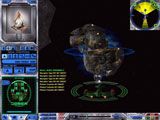 This wouldn’t be
so bad if you had an unlimited amount of time to figure things out, but
you don’t. Once you’re issued an order to report to a certain location,
the computer gives you a limited amount of time to get there before it
decides you’re lost and teleports you there automatically. This wouldn’t
be a problem if it had some regard for your current activity, such as
buying supplies at a star base, before whisking you spiritedly away to
your next encounter. It doesn’t. It was particularly annoying when,
after a few minutes in port deciding how many men I wanted to have for
boarding parties, it took over my controls and sped me away just before
I clicked the purchase button a few times. I then found myself entering
a mission with orders to capture, but not destroy, an enemy ship. Want
to know how many soldiers I’d managed to stock before my unexpected
departure? Zero. I had to quit the mission and re-load a previous save.
In a game that is so detailed and well done in many other respects,
you’d think the computer would make sure you had the ability to complete
a mission before sending you in with no way out. Thinking, in this case
though, would lead you astray. This wouldn’t be
so bad if you had an unlimited amount of time to figure things out, but
you don’t. Once you’re issued an order to report to a certain location,
the computer gives you a limited amount of time to get there before it
decides you’re lost and teleports you there automatically. This wouldn’t
be a problem if it had some regard for your current activity, such as
buying supplies at a star base, before whisking you spiritedly away to
your next encounter. It doesn’t. It was particularly annoying when,
after a few minutes in port deciding how many men I wanted to have for
boarding parties, it took over my controls and sped me away just before
I clicked the purchase button a few times. I then found myself entering
a mission with orders to capture, but not destroy, an enemy ship. Want
to know how many soldiers I’d managed to stock before my unexpected
departure? Zero. I had to quit the mission and re-load a previous save.
In a game that is so detailed and well done in many other respects,
you’d think the computer would make sure you had the ability to complete
a mission before sending you in with no way out. Thinking, in this case
though, would lead you astray.
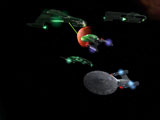 These sorts
of shortfalls, the type that don’t ruin the game but tarnish slightly
upon close inspection, appear in other areas as well. For example, in
the combat sequences, when you take your hard earned and painstakingly
equipped ship into battle, what you witness is played out entirely on a
two-dimensional map. Oh, sure, the ships all look pretty good, but while
dog fighting in space you have the options of moving left or right, not
up or down. There are few times when this is more evident than when two
ships fly over each other. Head on head, the two will overlap, appearing
to be at slightly elevations, merely flying over one another. However,
if the two ships are turning when they cross, often times the wing of
one Klingon Warbird will pass quite cleanly and evidently through the
wing of another. This is not a glaring error. It does not diminish the
game substantially. It is one, however, of several small elements that
evidently could have used a bit more polish. These sorts
of shortfalls, the type that don’t ruin the game but tarnish slightly
upon close inspection, appear in other areas as well. For example, in
the combat sequences, when you take your hard earned and painstakingly
equipped ship into battle, what you witness is played out entirely on a
two-dimensional map. Oh, sure, the ships all look pretty good, but while
dog fighting in space you have the options of moving left or right, not
up or down. There are few times when this is more evident than when two
ships fly over each other. Head on head, the two will overlap, appearing
to be at slightly elevations, merely flying over one another. However,
if the two ships are turning when they cross, often times the wing of
one Klingon Warbird will pass quite cleanly and evidently through the
wing of another. This is not a glaring error. It does not diminish the
game substantially. It is one, however, of several small elements that
evidently could have used a bit more polish.
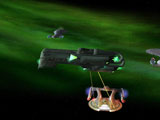 The action
of the game is provided through the combat sequences, fought in this two
dimensional, third person perspective with a dizzying array of options,
commands, and details to remember. This actually represents a dumbing
down of the series, which used to be complex to the point of confusion,
out of the easy reach for many players. Weapons are directional,
depending on what type of ship your flying and what side you’re flying
for (the Federation tends to have weapons placed in a wider spread,
often around the saucer section, while Klingons tend to direct their
fire more heavily in a single direction, etc.), and so much of your
combat involves bringing your ship to bear in such a way that the enemy
can’t open fire, but you can. Taking advantage of your cloaking device
and tractor beams, boarding parties and combat controls is very
important to victory, and provide quite a variety of tactics and style
that change from race to race (the Borg, for example, just like to grab
onto you and starting pounding away. Jerks). Aside from some confusing
perspective shifts whenever an enemy cloaks while you are tracking him
(making it very difficult to guess where he was going) the combat
elements of the game are entertaining and addictive, with a system of
control that is much streamlined and simplified from the Starfleet
Command games of the past. While still complex, the learning-curve-hill
is one easily climbed with a bit of your time, especially since Picard
does the teaching. Again, though, there are questionable elements. While
the voice acting is excellent, capturing the essence of the characters
nearly perfectly, what they say is often a waste of time, and simply
pointless. Often times you’ll start a mission with some brief
ship-to-ship communications, a bit of banter from another captain or two
outlining your mission. After something is said to you, you are then
presented with a list of possible responses. Don’t even bother reading,
because most of the time it doesn’t make a difference what you say. Your
dialogue is empty. While you do have control of some minor and immediate
outcomes, affecting slight variations in people depending on how you
address them, characters in the game ultimately end up saying the same
things regardless of how you get there, and a good portion of the time
the computer will select a response for you if you take to long. In
short, the dialogue elements of the game seem to be presented in an
outdated, somewhat worthless way. The action
of the game is provided through the combat sequences, fought in this two
dimensional, third person perspective with a dizzying array of options,
commands, and details to remember. This actually represents a dumbing
down of the series, which used to be complex to the point of confusion,
out of the easy reach for many players. Weapons are directional,
depending on what type of ship your flying and what side you’re flying
for (the Federation tends to have weapons placed in a wider spread,
often around the saucer section, while Klingons tend to direct their
fire more heavily in a single direction, etc.), and so much of your
combat involves bringing your ship to bear in such a way that the enemy
can’t open fire, but you can. Taking advantage of your cloaking device
and tractor beams, boarding parties and combat controls is very
important to victory, and provide quite a variety of tactics and style
that change from race to race (the Borg, for example, just like to grab
onto you and starting pounding away. Jerks). Aside from some confusing
perspective shifts whenever an enemy cloaks while you are tracking him
(making it very difficult to guess where he was going) the combat
elements of the game are entertaining and addictive, with a system of
control that is much streamlined and simplified from the Starfleet
Command games of the past. While still complex, the learning-curve-hill
is one easily climbed with a bit of your time, especially since Picard
does the teaching. Again, though, there are questionable elements. While
the voice acting is excellent, capturing the essence of the characters
nearly perfectly, what they say is often a waste of time, and simply
pointless. Often times you’ll start a mission with some brief
ship-to-ship communications, a bit of banter from another captain or two
outlining your mission. After something is said to you, you are then
presented with a list of possible responses. Don’t even bother reading,
because most of the time it doesn’t make a difference what you say. Your
dialogue is empty. While you do have control of some minor and immediate
outcomes, affecting slight variations in people depending on how you
address them, characters in the game ultimately end up saying the same
things regardless of how you get there, and a good portion of the time
the computer will select a response for you if you take to long. In
short, the dialogue elements of the game seem to be presented in an
outdated, somewhat worthless way.
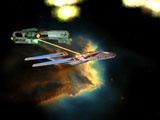 Which
brings me to a sad confession. One of the most intriguing elements of
Starfleet Command III is the online Dynaverse, a dynamic universe
supported by the game that allows you to play through the internet with
your pals. While many developers would have been tempted to include only
the action combat in the multiplayer arena, allowing players to blow
each other up one on one or in teams without a purpose, it’s a sign of
Starfleet Command’s quality that the entire game is ported online
instead. The multiplayer elements play out very similar to the single
player campaigns, with a hex map, warring empires, and space stations
used to restock and repair. Instead of going on missions with strictly
computer controlled allies and enemies, though, you’ll find human
beings. However, I never made it online. Be forewarned that the network
requires your computer to have an outside visible IP address in order to
access the Dynaverse servers, meaning no router assigned IPs. If you’re
running on a DHCP system (which is me), you’re squat out of luck. It was
disappointing to me that I was unable to utilize the element of the game
that held the most promise. Which
brings me to a sad confession. One of the most intriguing elements of
Starfleet Command III is the online Dynaverse, a dynamic universe
supported by the game that allows you to play through the internet with
your pals. While many developers would have been tempted to include only
the action combat in the multiplayer arena, allowing players to blow
each other up one on one or in teams without a purpose, it’s a sign of
Starfleet Command’s quality that the entire game is ported online
instead. The multiplayer elements play out very similar to the single
player campaigns, with a hex map, warring empires, and space stations
used to restock and repair. Instead of going on missions with strictly
computer controlled allies and enemies, though, you’ll find human
beings. However, I never made it online. Be forewarned that the network
requires your computer to have an outside visible IP address in order to
access the Dynaverse servers, meaning no router assigned IPs. If you’re
running on a DHCP system (which is me), you’re squat out of luck. It was
disappointing to me that I was unable to utilize the element of the game
that held the most promise.
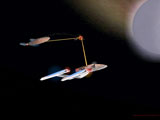 That
aside, though, Starfleet Command III still presents a strong showing.
With the new streamlined controls and straightforward interface, this is
a title straight out of the highlight days of TNG. Even without the
multiplayer elements, Starfleet Command allows for some tremendously
addicting micromanagement in terms of equipping your ship, and some
engaging and entertaining combat. Where many games would have one or two
strong elements, STCIII looks good from all angles, and contains enough
campaign options to keep a gamer interested for a long time to come. If
you just got out of Nemesis and find yourself wanting to spend some
quality time with old reruns and a familiar Federation, Starfleet
Command III offers an experience about as rewarding as Star Trek games
have to offer. This is one to make you warm in the heart. That
aside, though, Starfleet Command III still presents a strong showing.
With the new streamlined controls and straightforward interface, this is
a title straight out of the highlight days of TNG. Even without the
multiplayer elements, Starfleet Command allows for some tremendously
addicting micromanagement in terms of equipping your ship, and some
engaging and entertaining combat. Where many games would have one or two
strong elements, STCIII looks good from all angles, and contains enough
campaign options to keep a gamer interested for a long time to come. If
you just got out of Nemesis and find yourself wanting to spend some
quality time with old reruns and a familiar Federation, Starfleet
Command III offers an experience about as rewarding as Star Trek games
have to offer. This is one to make you warm in the heart.
Aaron Stanton (01/07/2003) |
|
Snapshot
Ups:
Nice to see Starfleet Command step into the Next
Generation; good voice acting; fun, detailed, and much more mainstream
than past installments.
Downs:
Not a true 3D world; poor dialogue options; a few
interesting design flaws sometimes force you to reload saves in order to
progress the story; doesn't let you keep the ships you capture.
Platform:
PC
|
|
|
|
|
|
|
|
